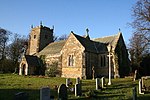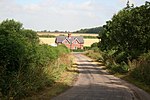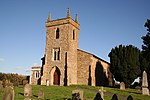Hainton

Hainton is a village and civil parish in the East Lindsey district of Lincolnshire, England. It is situated on the A157 road, 10 miles (16 km) west from Louth and 5 miles (8 km) south-east from Market Rasen. Hainton is listed in the Domesday Book of 1086 as "Haintone", with 9 villagers, 2 smallholders, 1 freeman, and 100 acres (0.4 km2) of meadow, and given over to Ilbert of Lacy as Lord of the Manor.The village is the site of a medieval settlement, with evidence of earthworks indicating a ridge and furrow field system and crofts.In 1885 Kelly's Directory recorded a now listed school built by G. F. Heneage in 1846. Agricultural production in the 2,306-acre (9.33 km2) parish was chiefly wheat, barley, oats and turnips.
Excerpt from the Wikipedia article Hainton (License: CC BY-SA 3.0, Authors, Images).Hainton
A157, East Lindsey
Geographical coordinates (GPS) Address Nearby Places Show on map
Geographical coordinates (GPS)
| Latitude | Longitude |
|---|---|
| N 53.342923 ° | E -0.223086 ° |
Address
A157
LN8 6LX East Lindsey
England, United Kingdom
Open on Google Maps











